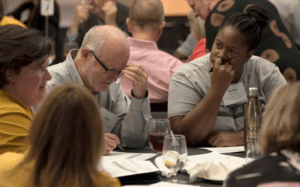For the past few decades, institutions of higher education have been making strides in the collection and use of data to inform their decisions. From enrollment data to student surveys, outcome metrics to predictive analytics, institutions collect more information on how their students move through their educational journey than ever before. These data have informed decisions on almost every aspect of the institution, providing leaders with tangible evidence of what’s working and what needs to be addressed to increase student success.
ATD’s recently released guidebook, Knowing Our Students: Understanding & Designing for Success, challenges colleges to leverage new data to build a more holistic understanding of their students so they can design an experience that embraces the whole student. The guidebook includes strategies, tools, and case studies to support colleges in deepening their understanding of their students. It also introduces student-centered design, a process for solving complex problems adapted from design thinking, as a tool to help institutions use data about their students to inform decisions at both the strategic and day-to-day level.
Northern Kentucky University (NKU), an institution that serves over 15,000 students in the suburbs of northern Kentucky, reframed their understanding of the students they serve and successfully used tools from student-centered design.
Community-driven strategic planning: How Northern Kentucky University leveraged student-centered design to build an inclusive strategic planning process
In 2018, while celebrating its 50-year anniversary, Northern Kentucky University welcomed a new president who challenged the college to reframe its thinking about who the institution serves and how they design programs, services, and learning experiences to meet their students where they are.
Download the case study
NKU staff and faculty at a strategic planning meeting. Image courtesy of NKU
As the strategic planning process began, NKU’s president, Dr. Ashish Vaidya, called upon campus leadership to reframe thinking on program design, services, and learning experiences to meet students’ overarching academic and support needs. The institution adapted Vijay Govindarajan’s Three-Box Solution as a guiding framework for the process to encourages the institution to develop a plan that addresses the past, present, and future.
- Box 1: the present. We must improve on the things we are currently doing in ways that will yield better results for access, completion, and career & community engagement.
- Box 2: the past. We must learn from and selectively forget the past processes that hinder access, completion, and career & community engagement.
- Box 3: the future. We must design new, innovative ways to serve current and future students, ensuring their success with regards to access, completion, and career & community engagement.
Building upon the three-box solution, a dedicated team of 12 administrators, faculty, staff, students, and community members used tools from design thinking to gather extensive data from their students. The team held over 2,000 face-to-face events, deployed surveys, conducted interviews, and facilitated pop-in feedback opportunities. After thoroughly analyzing the data, they were able to provide a foundation for identifying the needs for their strategic plan.
“When we broaden our focus beyond 18-year-olds and meet students where they are, understanding the complexity of their identities and experiences, we fulfill our promise to both our students and our regional employers and partners.”
– Bonita Brown, vice president and chief strategy officer at Northern Kentucky University
After eight months of work focusing on becoming a “student-ready” institution, the team’s three-year strategic framework, known as the “Success by Design” Framework, was approved by NKU’s board of regents. Grounded in NKU’s mission, vision, and values, the strategic framework identifies three pillars: access, completion, and career and community engagement. Each of the pillars is defined by goals and objectives which informed the development of the institution’s strategic goals and objectives which, in turn, guided the projects that ended up in each of the three boxes (present, past, and future).
To fill these boxes with impactful projects, the institution launched an effort to engage the whole campus community in the brainstorming phase of the student-centered design process. Through the 2020 NKU Innovations Challenge, students, faculty, staff, and community members presented their projects to a selection panel, which selected 10 student success and equity projects to fund as part of the strategic plan.
Key projects chosen included:
- A partnership with local high schools to train and credential high school faculty to teach dual-credit courses in high demand courses.
- A second-year retention program for Black students that offers career workshops and networking opportunities
- Increased access to market-relevant postsecondary certificate to currently incarcerated individuals in a local female prison
NKU leadership credits its Success by Design Framework with encouraging innovations that centered the reality and complexity of the lives of their students. By including students’ voices and treating them as the experts, NKU administrators, staff, and faculty were able to make more informed decisions, which leadership is certain will lead to an improved student experience and greater student success.